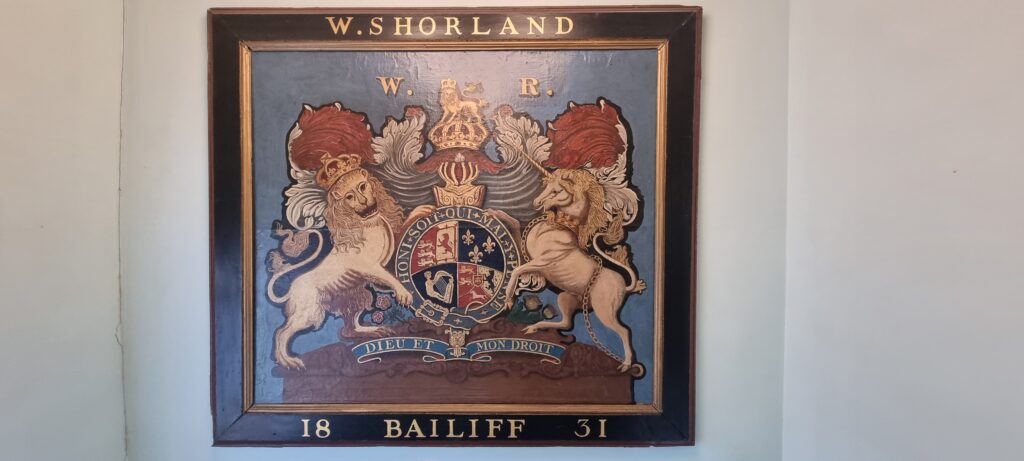Have you ever looked at the Coat of Arms mounted on the wall of the half landing in the Town Hall?
I was speculating on its relevance to Ilchester. It has been pointed out by the Rev. Francis Sutcliffe that it had been doctored by, one assumes William Shorland (Bailiff to the Town Trust) as it now bears his name. If you look at the black section at the bottom of the board you can make out a date of 1793.
This places the arms in the reign of George III not William IV as implied on the board. Intrigued I decided to do some delving to see if I could make any sense of it’s presence.
This is what I discovered:
It is the Royal coat of arms dating between 1760 and 1801. The British Royal coat of arms are pictorial representing the main countries over which the monarch rules rather than being personal arms.
George III inherited the arms of the last Stuart monarch, Queen Anne. He added a quarter of his territory, the Electorate of the Duchy of Brunswick and Luneburg commonly known as Hanover.
Looking at the 1st coat of arms the top left hand quarter are the 3 lions of England and the red lion of Scotland representing the Act of Union of 1707 and the creation of the kingdom of Great Britain. To its right is the Fleurs-de-Lys of France which had been relegated to the 2nd quarter as there had been no claim to French land since Tudor times. The harp of Ireland was still in the 3rd quarter as Ireland had been technically in personal union with the English crown since the Irish parliament had passed the Crown of Ireland Act in 1542 proclaiming Henry VIII to be king of Ireland. The Hanoverian arms made up the 4th quarter.
The Act of Union in 1800 coming into effect in 1801 created the Kingdom of Great Britain and Ireland. At the same time George III abandoned the historical claims to the French throne as France had become a republic. When the Treaty Of Amiens was ratified in March 1802 the Royal coat of arms were changed and remained so until 1816.
Now the mystery of who and why they painted and mounted in the Town Hall?
One possibility as to why could be that it was the year that the French 1st Republic declared war on Britain. Was it a patriotic gesture?
As to who well that’s difficult to say. It was a time when Ilchester’s governance was again in flux. I have tried to find the name of the Bailiff in that year with no success as yet. Steven-cox records have a gap in the list of names between 1755 to 1831. The Somerset records index doesn’t look more hopeful though searching the documents might throw a light. However it appears in 1792 the Corporation exchanged all properties in Ilchester for a more profitable estate in Odcombe, owned by a Richard Troward a London Attorney (steeped in wheeler dealing in parliamentary practices), thus loosing interest in the borough as land lords and temporarily ceasing to be an important factor in Parliamentary elections. Troward naturally packed the corporation with his own men ensuring the outcome he wanted.
Was it Troward who authorised the painting of the coat of arms? Did the corporation become lax in keeping records?
If anyone has any other information, do let me know.
Sally Mottram

